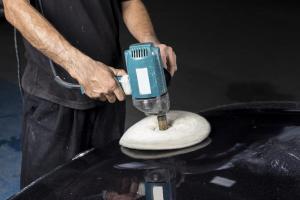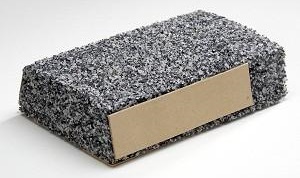Алюминия оксид химические свойства, назначение, производство
Описание
Aluminum(III) oxide is also called aluminum oxide. In mineral form it is called corundum and is referred to as alumina in conjunction with mining and aluminum industries. Alumina exists in hydrated forms as alumina monohydrate, Al2O3?H2O and alumina trihydrate Al2O3?3H2O. The geologic source of aluminum is the rock bauxite, which has a high percentage of hydrated aluminum oxide. The main minerals in bauxite are gibbsite (Al(OH)3), diaspore (AlO(OH)), and boehmite (AlO(OH).
Химические свойства
Aluminum oxide occurs as a white crystalline powder. Aluminum
oxide occurs as two crystalline forms: α-aluminum oxide is
composed of colorless hexagonal crystals, and γ-aluminum oxide
is composed of minute colorless cubic crystals that are transformed
to the α-form at high temperatures.
Физические свойства
Al2O3 Colorless hexagonal crystal; refractive index 1.768; density 3.965 g/cm3 (at 25°C); mp 2072°C; bp 2980°C; insoluble in water
α-Al2O3 Colorless rhombic crystal; mp between 2005 to 2025°C ; density 4.022 g/m3 ; hardness 9Moh
γ-Al2O3 white microscopic crystal
Al2O3•H2O colorless rhombic crystal; refractive index 1.624; density 3.014 g/cm3
Al2O3•3H2O white monoclinic crystal; refractive index 1.577; density 2.420 g/cm3
All forms are insoluble in water.
Физические свойства
White and translucent hard
material used as abrasive for
grinding. Excellent electric
insulator and also wear
resistant. Insoluble in water and
in strong mineral acids, readily
soluble in strong alkali
hydroxides, attacked by HF or
NH4HF2. Owing to its corrosion
resistance, in inert atmosphere,
in molten metals such as Mg, Ca,
Sr, Ba, Mn, Sn, Pb, Ga, Bi, As, Sb,
Hg, Mo, W, Co, Ni, Pd, Pt, and U
it is used as crucible container
for these liquid metals. Alumina
is readily attacked in an inert
atmosphere by molten metals
such as Li, Na, Be, Al, Si, Ti, Zr,
Nb, Ta, and Cu. Maximum
service temperature 1950°C
Вхождение
Occurs in nature in abundance; the principal forms are bauxites and laterites. The mineral corundum is used to produce precious gems, such as ruby and sapphire. Activated aluminas are used extensively as adsorbents because of their affinity for water and other polar molecules; and as catalysts because of their large surface area and appropriate pore sturcture. As adsorbents, they are used for drying gases and liquids; and in adsorption chromatography. Catalytic properties may be attributed to the presence of surface active sites (primarily OH- , O2- , and Al3+ ions). Such catalytic applications include sulfur recovery from H2S (Clauss catalysis); dehydration of alcohols, isomerization of olefins; and as a catalyst support in petroleum refining.
Характеристики
Aluminum Oxide (Alumina) is the most widely used oxide, chiefly because it is plentiful, relatively low in cost, and equal to or better than most oxides in mechanical properties. Density can be varied over a wide range, as can purity — down to about 90% alumina — to meet specific application requirements. Alumina ceramics are the hardest, strongest, and stiffest of the oxides. They are also outstanding in electrical resistivity, dielectric strength, are resistant to a wide variety of chemicals, and are unaffected by air, water vapor, and sulfurous atmospheres. However, with a melting point of only 2039°C, they are relatively low in refractoriness, and at 1371°C retain only about 10% of room-temperature strength. In addition to its wide use as electrical insulators and its chemical and aerospace applications, the high hardness and close dimensional tolerance capability of alumina make this ceramic suitable for such abrasion-resistant parts as textile guides, pump plungers, chute linings, discharge orifices, dies, and bearings.
Использование
- As adsorbent, desiccant, abrasive,thickening and anti-caking agent;
- As filler for paints and varnishes;
- In manufacture of alloys,refractories, ceramic materials, electrical insulators and resistors, dental cements, glass, steel, artificial gems; in coatings for metals, etc.;
- As catalyst for organic reactions.
- As an insoluble carrier for mineral pigment, and is frequently mixed into mineral powder makeup. Because of its abrasive texture, many use these crystals to exfoliate and resurface the skin-particularly with Microdermabrasion.
- As a chromotagraphic matrix; originally called Brockmann aluminum oxide when used for this purpose.
- The minerals corundum (hardness = 9) and Alundum (obtained by fusing bauxite in an electric furnace) are used as abrasives and polishes;
- In manufacture of cosmetic products like blush, powder foundation, lipstick and facial cleanser.


Определение
The mineral corundum
is natural aluminum oxide, and emery, ruby, and
sapphire are impure crystalline varieties. The mixed
mineral bauxite is a hydrated aluminum oxide.
Подготовка
Pure Aluminum oxide, needed to produce aluminum by the Hall process, is made by the Bayer process. The starting material is bauxite (Al2O3 • nH2O). The ore contains impurities, such as, SiO2, Fe2O3, TiO2, and Na2O. Most impurities are removed following treatment with caustic soda solution. Bauxite is dissolved in NaOH solution. Silica, iron oxides and other impurities are filtered out of the solution. CO2 is then bubbled through this solution. This precipitates are heated to remove water and produce Al2O3. These impurities are removed. Calcinations of bauxite produce Aluminum oxide of abrasive and refractory grades. Activated Aluminum oxide of amorphous type, as well as the transition Aluminum oxides of γ, η, χ, and ρ forms, are obtained from various aluminum hydroxides, such as, α- and β-trihydrates, α-monohydrate and Aluminum oxide gel. Such chemicals are also obtained from bauxite by the Bayer process.
Методы производства
The Bayer process begins by grinding the bauxite and mixing it with sodium hydroxide in a digester. The sodium hydroxide dissolves aluminum oxide components to produce aluminum hydroxide compounds. For gibbsite, the reaction is: Al(OH)3 + NaOH → Al(OH)4- + Na+. Insoluble impurities such as silicates, titanium oxides, and iron oxides are removed from the solution while sodium hydroxide is recovered and recycled. Reaction conditions are then modified so that aluminum trihydroxide (Al(OH)3) precipitates out. The reaction can be represented as the reverse of the previous reaction: Al(OH)4- + Na+ → Al(OH)3 + NaOH. Aluminum trihydroxide is calcined to drive off water to produce alumina:
Al(OH)3 Al2O3 + 3H2O.
Реакции
Aluminum oxide exhibits amphoteric behavior. It is soluble both in acids and bases. With acids, it produces their corresponding salts. It froms Al2(SO4)3, Al(NO3)3 and AlCl3 upon reactions with H2SO4, HNO3, and HCl, respectively. In acid medium, it exists as a solvated aluminum ion, in which water molecules are hexacoordinated to trivalent Al3+, as shown below:
Al2O3 + 6H3O+3H2O ——› 2[Al(H2O)6]3+
(Rollinson, C. L., 1978., Aluminum Compounds. In Kirk-Othmer Encyclopedia of Chemical Technology, 3rd ed. Vol 2, pp 188-97. NY,: Wiley Interscience)
Aluminum oxide forms hydroxide in aqueous alkaline solution. The reaction is slow. The products, aluminum hydroxides (hydrated aluminas), contain hexacoordinated aluminohydroxide anion:
Al2O3 + 2OH– + 7H2O → 2[Al(OH)4(H2O)2]–
In its dry state, Aluminum oxide exhibiting basicity reacts with silica, forming aluminum silicate
Al2O3 + 3SiO2 → Al2(SiO3)3
Similarly, with basic CaO or MgO aluminate salts are formed
MgO + Al2O3 → Mg(AlO2)2 CaO + Al2O3 → Ca(AlO2)2
It forms aluminum nitride, AlN when heated with coal in a stream of nitrogen; and aluminum borate, Al2O3 •B2O3 when heated with B2O3 at 1000°C.
Общее описание
White odorless crystalline powder. Water insoluble. Properties (both physical and chemical) vary according to the method of preparation; different methods give different crystalline modifications. The variety formed at very high temperature is quite inert chemically.
Реакции воздуха и воды
Insoluble in water.
Профиль реактивности
Aluminum oxide is chemically amphoteric (behaves as a weak acid in the presence of base and as a weak base in the presence of acid). May act catalytically. May cause the exothermic polymerization of ethylene oxide. May cause the vigorous polymerization of vinyl chloride [MCA SD-75, 1970]. The degree of subdivision of the Aluminum oxide may affect the vigor of such reactions.
Опасность
Toxic by inhalation of dust. Confirmed car-
cinogen.
Угроза здоровью
The aluminas are considered to
be nuisance dusts; their role in fibrogenic lung
disease remains unclear.
Assessment of the toxicity of aluminas has
been complicated by the chemical and physical
variants of the compounds and inconsistencies
in the nomenclature used to describe them.1
The group of compounds referred to as aluminas
is composed of various structural forms of
aluminum oxide, trihydroxide, and oxyhydroxide.
2 As these aluminas are heated, dehydration
occurs, producing a variety of transitional
forms; temperatures between 200 and 500°C
result in low-temperature-range transitional aluminas characterized by increased catalytic
activity and larger surface area.(Transitional
aluminas include c, h, and g forms, which,
taken together, were formerly termed “g.”)
Фармацевтические приложения
Aluminum oxide is used mainly in tablet formulations.It is used
for decoloring powders and is particularly widely used in antibiotic
formulations. It is also used in suppositories, pessaries, and urethral
inserts. Hydrated aluminum oxide is used in
mordant dyeing to make lake pigments, in cosmetics, and
therapeutically as an antacid.
Профиль безопасности
Suspected carcinogen with experimental neoplastigenic and tumorigenic data by implantation. Inhalation of finely divided particles may cause lung damage (Shaver's disease). Exothermic reaction above 200℃ with halocarbon vapors produces toxic HCl and phosgene. See also ALUMINUM COMPOUNDS
Безопасность
Возможный контакт
Most hazardous exposures to aluminum occur in smelting and refining processes. Aluminum is mostly produced by electrolysis of Al2O3 dissolved in molten cryolite (Na3AlF6). Aluminum is alloyed with copper, zinc, silicon, magnesium, manganese, and nickel; special additives may include chromium, lead, bismuth, titanium, zirconium, and vanadium. Aluminum and its alloys can be extruded or processed in rolling mills, wire works, forges, or foundries; and are used in the shipbuilding, electrical, building, aircraft, automobile, light engineering, and jewelry industries. Aluminum foil is widely used in packaging. Powdered aluminum is used in the paints and pyrotechnic industries. Alumina, emery, and corundum has been used for abrasives, refractories, and catalysts; and in the past in the first firing of china and pottery.
хранилище
Aluminum oxide should be stored in a well-closed container in a
cool, dry, place. It is very hygroscopic.
Перевозки
UN1309 Aluminum powder, coated, Hazard Class: 4.1; Labels: 4.1-Flammable solid. UN1383 Pyrophoric metals, n.o.s. or Pyrophoric alloys, n.o.s., Hazard Class: 4.2; Labels: 4.2-Spontaneously combustible material, Technical Name Required. UN1396 Aluminum powder, uncoated, Hazard Class: 4.3; Labels: 4.3-Dangerous when wet material. NA9260 (North America) Aluminum, molten, Hazard class: 9; Labels: 9-Miscellaneous hazardous material.
Методы очистки
Stir the oxide with hot 2M HNO3, either on a steam bath for 12hours (changing the acid every hour) or three times for 30minutes, then wash it with hot distilled water until the washings have pH 4, and follow by three washings with hot MeOH. The product is dried at 270o [Angyal & Young J Am Chem Soc 81 5251 1959]. For the preparation of alumina for chromatography see Chapter 1. [For � , � and � Al2O3 see Becher in Handbook of Preparative Inorganic Chemistry (Ed. Brauer) Academic Press Vol I p 822-823 1963 and Wagner in Handbook of Preparative Inorganic Chemistry (Ed. Brauer) Academic Press Vol II p 1662 1965.]
Несовместимости
Aluminum oxide should be kept well away from water. It is
incompatible with strong oxidizers and chlorinated rubber.
Aluminum oxide also reacts with chlorine trifluoride, ethylene
oxide, sodium nitrate, and vinyl acetate. Exothermic reactions
above 2008℃ with halocarbon vapors produce toxic hydrogen
chloride and phosgene fumes.
Утилизация отходов
Consult with environmental regulatory agencies for guidance on acceptable disposalpractices. Generators of waste containing this contaminant (≥100 kg/mo) must conform with EPA regulations governing storage, transportation, treatment, and waste disposal of Aluminum Oxide-Disposal in a sanitary landfill. Mixing of industrial process wastes and municipal wastes at such sites is not encouraged however. Aluminum powder may be recovered and sold as scrap. Recycling and recovery is a viable option to disposal for aluminum metal and aluminum fluoride (A-57).
Регуляторный статус
Included in the FDA Inactive Ingredients Database (oral tablets and
topical sponge). Included in nonparenteral medicines licensed in the
UK.
Алюминия оксид препаратная продукция и сырье
сырьё
препарат